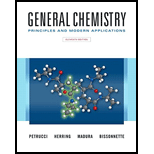
(a)
Interpretation:
The given radioactive process needs to be explained.
Concept introduction:
The emission of
- (a)Alpha decay
(b) Beta decay
(c) Gamma decay
Answer to Problem 1E
Explanation of Solution
In
Atomic number is equal to number of protons or number of electrons. Also, mass number is sum of number of protons and neutrons.
In beta decay, the number of electrons decreases thus, atomic number decreases to 25 but mass number remains the same.
(b)
Interpretation:
The given radioactive process needs to be explained.
Alpha decay of
Concept introduction:
The emission of electromagnetic radiation or particles from nucleus takes place in radioactive processes. The common radiations from emitted by nucleus are as follows:
- (a)Alpha decay
(b)Beta decay
(c)Gamma decay
Answer to Problem 1E
Explanation of Solution
In
Atomic number is equal to number of protons or number of electrons. Also, mass number is sum of number of protons and neutrons.
In alpha decay, the atomic number gets decreases by 2 unit and mass number decreases by 4 units thus, the new nucleus formed will have 234 as mass number and 90 as atomic number.
The element corresponding to atomic number 90 is thorium.
The nuclear reaction can be represented as follows:
(c)
Interpretation:
The given radioactive process needs to be explained.
Two successive alpha decay of
Concept introduction:
The emission of electromagnetic radiation or particles from nucleus takes place in radioactive processes. The common radiations emitted by nucleus are as follows:
- (a) Alpha decay
(b) Beta decay
(c)Gamma decay
Answer to Problem 1E
Explanation of Solution
In
Atomic number is equal to number of protons or number of electrons. Also, mass number is the total sum of both protons and neutrons.
In alpha decay, the atomic number gets decreases by 2 unit and mass number decreases by 4 units. In first alpha decay, the new nucleus formed will have 218 as mass number and 84 as atomic number.
The element corresponding to atomic number 84 is polonium.
The nuclear reaction can be represented as follows:
After second alpha decay, the new nucleus formed will have 214 as mass number and 82 as atomic number.
The element corresponding to atomic number 82 is lead.
The nuclear reaction can be represented as follows:
Thus, the nuclear reaction representing two successive alpha decays is as follows:
(d)
Interpretation:
The given radioactive process needs to be explained.
Two successive
Concept introduction:
The emission of electromagnetic radiation or particles from nucleus takes place in radioactive processes. The common radiations from emitted by nucleus are as follows:
- (a) Alpha decay
(b) Beta decay
(c) Gamma decay
Answer to Problem 1E
Explanation of Solution
In
Atomic number is equal to number of protons or number of electrons. Also, mass number is sum of number of protons and neutrons.
In beta decay, the number of electrons decreases and mass number remains the same.
In first beta decay, the new nucleus formed will have 64 as mass number and 28 as atomic number.
The element corresponding to atomic number 28 is nickel.
The nuclear reaction can be represented as follows:
After second beta decay, the new nucleus formed will have 64 as mass number and 27 as atomic number.
The element corresponding to atomic number 27 is cobalt.
The nuclear reaction can be represented as follows:
Thus, the nuclear reaction representing two successive beta decays is as follows:
Want to see more full solutions like this?
Chapter 25 Solutions
EBK GENERAL CHEMISTRY
- Don't use ai to answer I will report you answerarrow_forwardConsider a solution of 0.00304 moles of 4-nitrobenzoic acid (pKa = 3.442) dissolved in 25 mL water and titrated with 0.0991 M NaOH. Calculate the pH at the equivalence pointarrow_forwardWhat is the name of the following compound? SiMe3arrow_forward
- K Draw the starting structure that would lead to the major product shown under the provided conditions. Drawing 1. NaNH2 2. PhCH2Br 4 57°F Sunny Q Searcharrow_forward7 Draw the starting alkyl bromide that would produce this alkyne under these conditions. F Drawing 1. NaNH2, A 2. H3O+ £ 4 Temps to rise Tomorrow Q Search H2arrow_forward7 Comment on the general features of the predicted (extremely simplified) ¹H- NMR spectrum of lycopene that is provided below. 00 6 57 PPM 3 2 1 0arrow_forward
 ChemistryChemistryISBN:9781305957404Author:Steven S. Zumdahl, Susan A. Zumdahl, Donald J. DeCostePublisher:Cengage Learning
ChemistryChemistryISBN:9781305957404Author:Steven S. Zumdahl, Susan A. Zumdahl, Donald J. DeCostePublisher:Cengage Learning Chemistry: An Atoms First ApproachChemistryISBN:9781305079243Author:Steven S. Zumdahl, Susan A. ZumdahlPublisher:Cengage Learning
Chemistry: An Atoms First ApproachChemistryISBN:9781305079243Author:Steven S. Zumdahl, Susan A. ZumdahlPublisher:Cengage Learning
 Chemistry for Engineering StudentsChemistryISBN:9781337398909Author:Lawrence S. Brown, Tom HolmePublisher:Cengage Learning
Chemistry for Engineering StudentsChemistryISBN:9781337398909Author:Lawrence S. Brown, Tom HolmePublisher:Cengage Learning Chemistry by OpenStax (2015-05-04)ChemistryISBN:9781938168390Author:Klaus Theopold, Richard H Langley, Paul Flowers, William R. Robinson, Mark BlaserPublisher:OpenStax
Chemistry by OpenStax (2015-05-04)ChemistryISBN:9781938168390Author:Klaus Theopold, Richard H Langley, Paul Flowers, William R. Robinson, Mark BlaserPublisher:OpenStax





